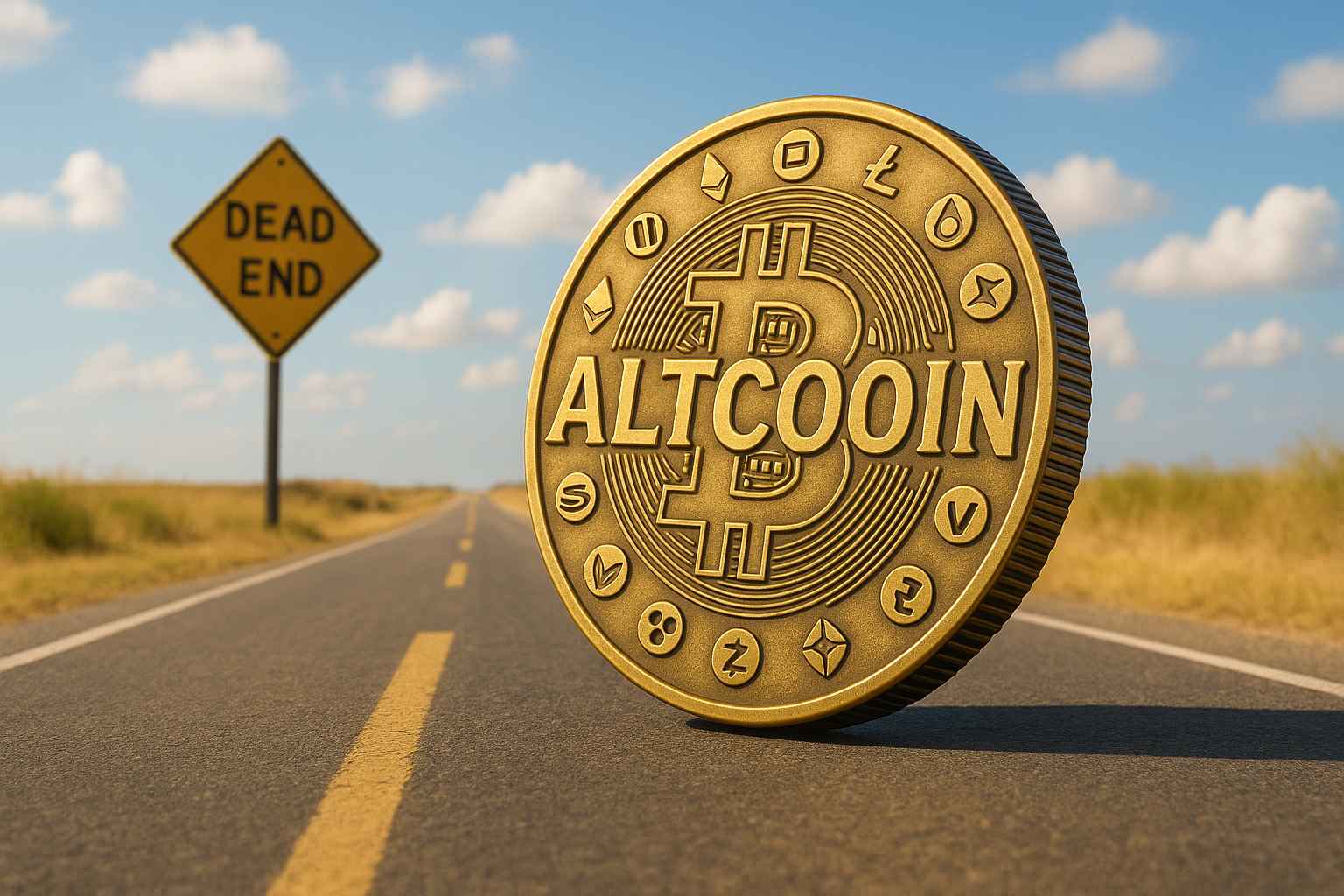The Harsh Reality Nobody Wants to Hear
Let’s face it — the crypto space isn’t the wild gold rush it used to be. Back in 2017 or even during the 2021 bull run, it felt like any random token could 10x overnight. Meme coins, dog coins, food coins — you name it, people threw money at it. But here’s the cold truth: the majority of these altcoins were built on hype, not substance. And 2025 might just be the year the final nail is hammered into their digital coffins.

If you’ve been holding on to a bag of obscure tokens hoping for a miracle comeback, you might want to brace yourself. The market’s maturing, regulations are tightening, and investors are getting smarter (finally). When you put all that together, the survival rate for altcoins doesn’t look pretty — in fact, it’s downright depressing.
The Glory Days of Altcoins Are Long Gone
Remember the days when even the weirdest coins pumped just because someone posted about them on Twitter? Those days were magical for early adopters but also incredibly dangerous for latecomers. People would jump in without reading a single whitepaper, let alone understanding what the project was about.
Now, the market isn’t as easily fooled. Investors have been burned one too many times. That blind faith in “next big thing” tokens? It’s mostly gone. Newcomers aren’t throwing money blindly — they’re cautious, skeptical, and quick to ask, “But what does it actually do?”
The Overpopulation Problem in Crypto
We don’t have a shortage of coins — we have the opposite problem. There are over 20,000 cryptocurrencies listed across various platforms, most doing the exact same thing as each other. It’s like having 20,000 brands of bottled water but half of them are just tap water in fancy packaging.
When there’s that much competition and almost no differentiation, survival becomes impossible. Just like in nature, when the ecosystem is overcrowded, weaker species vanish. And in the crypto jungle, weak projects disappear fast once the hype fades.
Regulations Are Coming — And They’re Not Friendly
One of the biggest reasons altcoins will crumble in 2025? Regulations. Governments worldwide are finally waking up to the fact that people are losing billions to scams and rug pulls. And when regulators step in, they don’t do it gently — they bulldoze the whole field.
If your favorite altcoin isn’t compliant with new laws, exchanges will simply delist it. No exchange listing means no liquidity. No liquidity means you can’t sell even if you wanted to. The crypto graveyard is about to get a lot more crowded thanks to lawmakers who have no patience for tokens without a legitimate use case.
Utility? Or Just Empty Promises?
Here’s the brutal truth — most altcoins exist for no reason other than to make their founders rich. They promise revolutionary technology, but when you strip away the buzzwords, they don’t solve any real-world problem. You can only hear “we’re the future of finance” so many times before you realize… these coins are just copy-paste projects with a different logo.
In 2025, investors will flock to coins with actual utility — think Ethereum for smart contracts, Chainlink for data oracles, or Polygon for scaling solutions. Everyone else? They’ll be left holding a token that no one wants to touch, like an expired gift card to a store that doesn’t exist.
The Bear Market Bloodbath
A bear market doesn’t just test patience — it wipes out the weak. During a bull run, even bad projects can ride the wave. But when prices drop, hype dies, and liquidity dries up, the market turns into a battlefield. Only the strongest survive.

If we see another brutal market crash in 2025, expect altcoins without strong fundamentals to vanish. The problem is, 90% of them fall into that category. They’ll drop so low that even the most optimistic holders will give up, selling for pennies or just abandoning their wallets.
Investor Fatigue Is Real
Crypto veterans have been through enough scams, hacks, and broken promises to last a lifetime. Many are tired of chasing “the next 100x” and would rather put money into safer, proven projects. That’s bad news for new altcoins that rely on fresh waves of hype to survive.
When the audience stops paying attention, the circus closes. And in 2025, that audience might shrink dramatically, leaving hundreds — if not thousands — of altcoins without anyone willing to invest.
Scams, Rug Pulls, and Lost Trust
Let’s not sugarcoat it — the altcoin market has been a breeding ground for scams. From pump-and-dump schemes to rug pulls that vanish overnight, the number of people burned is staggering. Trust is fragile, and in crypto, once it’s broken, it’s almost impossible to rebuild.
2025 could be the year trust finally runs out for “too-good-to-be-true” projects. People are tired of losing money to shady developers who disappear the moment the liquidity pool is drained. This shift in mindset will hit low-quality altcoins like a wrecking ball.
The Big Players Are Taking Over
Like it or not, crypto is becoming institutional. Big companies, traditional banks, and major exchanges are pouring resources into blockchain projects that have clear, regulated, and scalable goals. This means small, unproven tokens will be squeezed out of the market.
When the big fish move in, the little fish get eaten — or ignored. Your random micro-cap coin doesn’t stand a chance against billion-dollar corporate-backed crypto ventures. Investors will choose safety over wild speculation, leaving the majority of altcoins stranded.
The Meme Coin Hype Is Fading
Sure, Dogecoin and Shiba Inu had their moments, but the meme coin craze is dying. Investors are realizing that viral popularity alone doesn’t guarantee long-term survival. Without utility, these coins are like fireworks — flashy, loud, and gone in seconds.
By 2025, we might look back at meme coins the way we look at Beanie Babies or fidget spinners — a fun fad, but nothing worth serious investment.
Liquidity Death Spiral

Even if a token isn’t officially dead, it can still fall into a “liquidity death spiral.” That’s when the trading volume drops so low that you can’t sell without crashing the price. Investors notice, get scared, and sell — making the problem worse until the coin is essentially worthless.
It’s the crypto version of a ghost town: a blockchain still running, but with no one around to use it.
The Survivors: Who Will Make It?
Not all altcoins are doomed. Projects with strong fundamentals, real-world use cases, transparent teams, and active development have a fighting chance. Coins tied to DeFi infrastructure, gaming ecosystems, or cross-chain solutions might still thrive.
But make no mistake — survival will be the exception, not the rule. If you’re holding something with no clear purpose, now might be the time to rethink your strategy.
Conclusion: The Harsh But Necessary Purge
The death of 90% of altcoins in 2025 isn’t just possible — it might be necessary. Clearing out dead weight will allow truly innovative projects to shine. The market needs a cleanup, and while it’s painful for holders, it’s healthier for crypto in the long run.
It’s survival of the fittest, and in the blockchain world, hype doesn’t last forever. Utility, trust, and resilience do. The question is — will your altcoin be among the survivors, or just another name on the long list of forgotten tokens?
FAQs
1. Will all altcoins die in 2025?
No, but the majority could disappear due to regulations, low utility, and lack of investor interest.
2. How can I tell if my altcoin will survive?
Look for strong utility, active development, and real-world use cases, not just hype.
3. Will Bitcoin and Ethereum be safe?
They are far more likely to survive due to their dominance, adoption, and established ecosystems.
4. Should I sell my low-cap tokens now?
If they lack utility or adoption, it might be worth reconsidering your position before liquidity dries up.
5. Is the altcoin market over forever?
Not entirely — but the easy-money days are over, and future projects will face tougher scrutiny.
